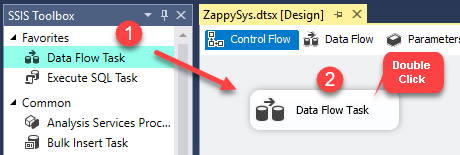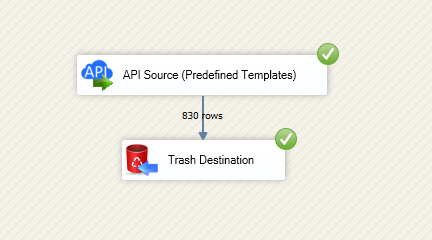Reading data in SSIS
In this section we will learn how to configure and use Shopify Connector in API Source to extract data from Shopify.
Video tutorial
This video covers following and more so watch carefully. After watching this video follow the steps described in this article.
- How to download SSIS PowerPack for Shopify integration in SSIS
- How to configure connection for Shopify
- How to read data from Shopify
- Features about SSIS API Source
- Using Shopify Connector in SSIS
Step-by-step instructions
-
Begin with opening Visual Studio and Create a New Project.
-
Select Integration Service Project and in new project window set the appropriate name and location for project. And click OK.
In the new SSIS project screen you will find the following:
- SSIS ToolBox on left side bar
- Solution Explorer and Property Window on right bar
- Control flow, data flow, event Handlers, Package Explorer in tab windows
- Connection Manager Window in the bottom
 Note: If you don't see ZappySys SSIS PowerPack Task or Components in SSIS Toolbox, please refer to this help link.
Note: If you don't see ZappySys SSIS PowerPack Task or Components in SSIS Toolbox, please refer to this help link. -
Now, Drag and Drop SSIS Data Flow Task from SSIS Toolbox. Double click on the Data Flow Task to see Data Flow designer.

-
From the SSIS toolbox drag and API Source (Predefined Templates) on the data flow designer surface, and double click on it to edit it:

-
Select New Connection to create a new connection:

-
Use a preinstalled Shopify Connector from Popular Connector List or press Search Online radio button to download Shopify Connector. Once downloaded simply use it in the configuration:
Shopify
-
Now it's time to configure authentication. Firstly, configure authentication settings in Shopify service and then proceed by configuring API Connection Manager. Start by expanding an authentication type:
Shopify authentication
Setting up your Shopify store account for API access involves creating an "app" for your store. The "app" is installed into the Shopify account and configured with the appropriate access levels for your data integration needs.- Visit https://accounts.shopify.com and log into your Shopify store account.
- After logging in, select the store to connect to with the ZappySys Shopify Connector.
- Select the Settings link (usually in the lower-left corner) to launch the Settings screen.
- On the left menu panel, select Apps and sales channels.
- On the Apps and sales channels screen, select Develop apps (near the top of the screen).
- On the App development screen, select Create an app (near the upper-right corner of the screen).
- Give the app that will be used to provide Shopify API access a name, select the appropriate developer from the App developer drop-down, and then select Create app.
- Select Configure Admin API scopes and the Admin API access scopes screen will appear.
-
In the Admin API access scopes screen, select every access scope checkbox that applies to your integration needs. It is generally not a good idea to allow more access than what is needed in order to fulfill your integration needs.
- To enable the reading of customer information, select read_customers.
- To enable the writing of customer information, select write_customers.
- To enable the reading of inventory item information, select read_inventory.
- To enable the writing of inventory item information, select write_inventory.
- To enable the reading of order information, select read_orders.
- To enable the writing of order information, select write_orders.
- Install the app by selecting the Install app button (near the upper-right corner of the screen). If any other prompts for installation appears, select Install.
- After the app is installed, the Admin API access token will be available in the API credentials tab of the page. It can only be revealed ONCE for security purposes. Select Reveal token once to show the new Admin API access token. SAVE THE ADMIN API ACCESS TOKEN IN A SAFE PLACE WHERE YOU HAVE IT CONFIDENTIAL, SECURE, AND NOT ACCESSIBLE TO UNAUTHORIZED INDIVIDUALS. The Admin API access token will be needed in this process later.
- In the ZappySys connector API screen, enter the subdomain of your Shopify store into the Subdomain parameter textbox. For example, if your Shopify URL is https://acmetoys.myshopify.com, the subdomain would be acmetoys.
- In the same screen, enter the Admin API access token saved from step 11 above into the Admin API Access Token textbox. In order to edit the text in this field, select the ellipses (...) button that appears when the textbox is clicked and edit the access token with the dialog box that appears.
- Select the Test Connection button at the bottom of the window to verify proper connectivity with the Shopify store.
- If the connection test succeeds, select OK.
API Connection Manager configuration
Just perform these simple steps to finish authentication configuration:
-
Set Authentication Type to
Access Token [Http] - Optional step. Modify API Base URL if needed (in most cases default will work).
- Fill in all the required parameters and set optional parameters if needed.
- Finally, hit OK button:
ShopifyAccess Token [Http]https://[$Subdomain$].myshopify.com/admin/api/2023-01Required Parameters Sub-domain Fill-in the parameter... Admin API Access Token Fill-in the parameter... Optional Parameters RetryMode RetryWhenStatusCodeMatch RetryStatusCodeList 429 RetryCountMax 5 RetryMultiplyWaitTime True 
-
Select the desired endpoint, change/pass the properties values, and click on Preview Data button to make the API call.
API Source - ShopifyShopify Connector can be used to integrate Shopify REST API in your App / BI Tools. You can read/write data about Customers, Orders, OrderItems, Products and more.

-
That's it! We are done! Just in a few clicks we configured the call to Shopify using Shopify Connector.
You can load the source data into your desired destination using the Upsert Destination , which supports SQL Server, PostgreSQL, and Amazon Redshift. We also offer other destinations such as CSV , Excel , Azure Table , Salesforce , and more . You can check out our SSIS PowerPack Tasks and components for more options. (*loaded in Trash Destination)
